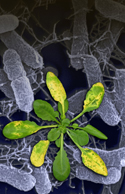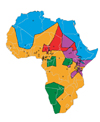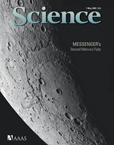 Plant-Microbe Interactions
Plant-Microbe Interactions
Introduction
to Special Issue
Plants, like animals, live immersed in a thriving community of
microbes. The diversity of fungi, bacteria, and other microorganisms
with which plants interact bring both plague and benefit. A special
section of the 8 May 2009 Science
highlighted recent advances in our understanding of the biochemistry,
signaling, and ecosystem dynamics that shape how microbes and plants
interact. A series of Perspectives looked at innate immunity in plants,
which is their first line of defense against potentially dangerous
microbes; the role of chemical diversity in plant defense; cross-talk
between plant hormonal and defense signaling pathways; how plants form
and maintain mutually beneficial interactions with microbes; and the
need for improved models of host-pathogen coevolutionary interactions
to help researchers predict the long-term consequences of different
types of human interventions on disease. A related Editorial discussed
how a deeper understanding of plant-microbe interactions is likely to
benefit efforts to improve plant health and productivity in
agricultural settings in the coming decades.
Living Counters
Synthetic biologists take much of their inspiration from computing and
electrical engineering, attempting to gain programmability in cells
using analogous genetic circuits. Engineered biological counters would
enable many applications, such as regulating cell death after a
specified number of cell divisions, noninvasive monitoring of aging,
and recording the frequency of environmental events. In the 29 May 2009
Science, Friedland
et al. reported an important step toward the construction of such
genetically encoded counters. The team constructed two complementary
synthetic genetic counters in E. coli
that can count up to three induction events (the counters trigger the
expression of a desired protein following the processing of two or
three input signal pulses). These molecular devices permit counting of
varied user-defined inputs over a range of frequencies and can be
expanded to count higher numbers. Similar devices may find application
in multi-event processes of cell biology, bioengineering, and,
potentially, therapeutics. An accompanying Perspective
by C. D. Smolke noted that important next steps include developing
circuits that can report on intermediate states, as well as the final
state, and circuits that allow counters to distinguish between
continuous and transient signals.
Safer Drug Target for Alzheimer's
Accumulation of the amyloid-beta (A-beta) protein in the brain is one
the hallmarks of Alzheimer's disease and is thought to trigger a
pathological cascade that ultimately results in neuronal dysfunction
and neurodegeneration. Therapies for the disease have therefore largely
focused on preventing or slowing A-beta aggretation, or breaking up
toxic A-beta aggregates. The gamma-secretase enzyme complex is
responsible for the final cleavage of A-beta from its precursor
protein, but the development of clinically useful inhibitors has proven
challenging. That's because the enzyme complex cleaves not only the
A-beta precursor, but also several important signaling proteins
including Notch1, which is important for controlling processes such as
cell growth, differentiation, and proliferation. As a result, treatment
of mice with general gamma-secretase inhibitors leads to various toxic
side effects including abnormalities in the skin and gastrointestinal
and immune systems (see the related Perspective
by T. E. Golde and T. L. Kukar). Now, in a Report in the 1 May 2009 Science, Serneels
et al. show that selective removal of the Aph1B component of the
gamma-secretase complex in a mouse model of Alzheimer's decreases the
formation of A-beta plaques and improves behavioral deficits without
the harmful side affects observed when targeting gamma-secretase more
generally. Drugs that specifically inhibit this component may therefore
be useful in treating the disease. The results may also have
implications for the treatment of various cancers in which
gamma-secretase is known to play role.
 African Population History
African Population History
Africa is the birthplace of modern humans, but genetic studies have so
far tended to under-represent African populations. As a result, the
extent of genetic diversity and the genetic relationships among the
continent's diverse populations have been unclear. Now, in a Research
Article in the 22 May 2009 Science
(published online 30 Apr), Tishkoff
et al. provide details of the largest study yet of African genetic
diversity. The team analyzed DNA from blood samples collected over a
decade from 113 geographically diverse African populations and found
that they can be traced back to 14 ancestral groups that often
correlate with self-described ethnicity and shared cultural and/or
linguistic properties (see the related News
story by A. Gibbons in the 1 May issue). The data reveal high
levels of mixed ancestry in most populations, reflecting historical
migration events across the continent. The data also provide evidence
for shared ancestry among geographically diverse hunter-gatherer
populations including Pygmies and Khoesan speakers of southern Africa.
Analysis of DNA from African Americans revealed that their ancestry is
predominantly (~71%) from populations in western Africa, 13% European,
and 8% from other African populations, although admixture levels varied
considerably among individuals. In a related podcast
interview lead author Sarah Tishkoff explained how the findings
will be informative for further studies aimed at reconstructing human
evolutionary history, understanding African-American ancestry, and for
identifying genetic risk factors for disease in Africa.
Imaging with Infrared
Proteins from jellyfish and corals that fluoresce in the visible
wavelength range have revolutionized optical imaging of cells. However,
these wavelengths are absorbed by hemoglobin, water, and lipid, thus
hindering the use of these proteins for deep-tissue imaging. In a
Report in the 8 May 2009 Science,
Shu
et al. described the engineering of a bacterial protein that can
emit infrared light, thus opening the door to new imaging applications
(see the related ScienceNOW story by R. F.
Service). The new protein is a modified version of a phytochrome from Deinococcus radiodurans -- a
bacterium renowned for its ability to survive huge doses of radiation.
The phytochrome normally absorbs deep-red light at the far end of the
visible spectrum and then uses that energy to send a signal to the cell
to turn on particular genes. By tinkering with the DNA that encodes the
protein, the teams created a protein that instead uses its energy to
create infrared light. The resulting infrared fluorescent proteins are
expressed well in mammalian cells and in mice. Because infrared can
pass through tissue more easily than visible light can, the advance
should allow researchers to trace individual molecules throughout the
bodies of mice and other small, live animals. Lead author of the study,
Xiaokun Shu, discussed the work in a related podcast
interview.
Ovulation Signals
In mammals, female reproductive success depends on the growth of
ovarian follicles, differentiation and proliferation of granulosa cells
-- ovarian cells that support the oocyte or egg -- as well as oocyte
maturation and ovulation. Failure to initiate or complete follicle
development, or defects in the oocyte, will result in infertility. In a
Report in the 15 May 2009 Science,
Fan
et al. described the cellular signaling pathways in the mouse ovary
that support follicle maturation and, ultimately, the release of a
mature egg. Luteinizing hormone (LH), released in monthly surges by the
pituitary gland, binds to its receptors on granulosa cells and plays a
critical role in ovulation and oocyte maturation. In the new study, the
researchers show that mitogen-activated protein kinases MAP1 and MAP 3
and (also known as ERK1/2) are essential downstream targets of this
hormonal signal. Engineered mice incapable of expressing ERK1/2 in
their granulosa cells displayed multiple disrupted ovarian processes,
including prolonged follicle development and failure of oocytes to
mature. The team also provided evidence that the transcription factor
C/EBPbeta is a critical downstream mediator of ERK1/2 activation. As
noted in an accompanying Perspective
by R. Duggavathi and B. D .Murphy, these findings could help elucidate
the underlying causes of ovarian pathologies and lead to therapies for
female infertility.
Death Mirroring Life
The accuracy with which fossil assemblages represent the actual
composition of ancient ecological communities is often uncertain,
especially during periods of rapid population and environmental change.
One way to assess the degree of fidelity between living and dead
assemblages is to compare modern living communities and the records
they leave behind them in real time. In a Report in the 22 May 2009 Science, Western
and Behrensmeyer presented their results of just such a study.
Using live population counts and bone surveys, the team tracked
correlations between dead and living populations of 15 herbivorous
species (14 mammals and ostrich) in the Amboseli reserve in southern
Kenya over 40 years (1964 to 2004). Over this time period, dense
woodlands and bushlands gave way to open grassland and large swamps,
the abundance of grazing animals increased relative to browsers, and
species richness declined. The team found that the relative abundance
of species recorded in the bone assemblages accurately tracked these
changes in community composition and habitat over intervals as short as
5 years and that the aggregated bone sample provides an accurate record
of community structure time-averaged over four decades. The findings
thus lay the groundwork for integrating paleobiological and
contemporary ecological studies across evolutionary and ecological time
scales.
 MESSENGER's Second
Mercury Flyby
MESSENGER's Second
Mercury Flyby
In October 2008, the spacecraft MESSENGER made its second of three
scheduled flybys of Mercury before it settles into the planet's orbit
in 2011. These flybys, together with observations collected by Mariner
10 in the mid-1970s, now provide a near-global look at the planet. Four
Reports in the 1 May 2009 Science
described observations from MESSENGER's second flyby and new insights
into Mercury's outer atmosphere and its surface. Two reports examined
the complexity of Mercury's magnetosphere, formed by solar wind
interaction with the planet's magnetic field (see the related Perspective
by K.-H. Glassmeier). Slavin
et al. reported observations of intense magnetic reconnection -- a
process in which the interplanetary magnetic field lines join the
magnetospheric field lines, transferring energy from the solar wind
into the magnetosphere -- 10 times as intense as that on Earth. McClintock
et al. reported on the detection of magnesium in Mercury's tenuous
exosphere, which presumably derived from surface materials, as well as
differing spatial distributions of magnesium, calcium, and sodium
atoms. Turning to the surface of Mercury, Denevi
et al. looked at the mechanisms that have shaped the planet's
crust, which likely formed by eruption of magmas of different
compositions over a long period of time. And Watters
et al. described the well-preserved Rembrandt Impact Basin, which
is the second largest known on the planet. The basin is only partially
flooded by volcanic plains and shows a unique pattern of radial and
concentric tectonic features, some of which result from Mercury's
contraction as its interior cooled over time.
Future Fuels
The escalating monetary and political costs of imported petroleum, as
well as growing concerns over the environmental impact of greenhouse
gas production, have accelerated efforts to develop more
environmentally friendly transportation fuels. Biomass has been
promoted as an important source of power for automobiles, either to
generate electricity for electric vehicles, or to make ethanol for
combustion vehicles. In a Report in the 22 May 2009 Science (published online 7 May), Campbell
et al. examined each approach's demands on land use, using a
lifecycle assessment model, for a range of energy feedstocks,
conversion methods, and vehicle types. The team found that in nearly
all cases, bioelectricity would have a significantly higher net
transportation efficiency per unit area of cropland used than
bioethanol, owing to the greater efficiency of electric engines.
Bioelectricity would also result in greater greenhouse gas offsets
(listen to the related podcast
interview with lead author Elliot Campbell). In a related Policy
Forum, Ohlrogge
et al. argued that "replacement of gasoline by bioelectricity in
cars and with diesel engines in heavier vehicles may be the best route
to the goal of reducing petroleum consumption and carbon dioxide
emissions."
Advances in Optical Lithography
Microscopists have achieved fluorescence imaging at subwavelength
resolution by focusing one beam of light in a halo around another beam,
thereby quenching the glow of fluorescent dyes in all but the very
center of the illuminated spot. Three studies in the 15 May 2009 Science (published online 9 Apr)
have adapted this approach to photolithography, the process used to
pattern the formation of electronic circuits on microchips. The new
approach allows small feature sizes to be created more easily and
inexpensively than with traditional approaches. Scott
et al. developed a two-color irradiation scheme in which a central
beam of one wavelength activates polymerization initiators, and a
surrounding halo-shaped beam of a second wavelength halts
polymerization in the surrounding area, thus enabling fine-detailed
patterning in the center of the "halo". Li et
al. found that use of a different initiator molecule allowed
both beams to share the same wavelength (800 nanometers), with a
relatively weak quenching beam lagging slightly behind an intense
initiating beam. Both of these techniques produced three-dimensional
features honed to subwavelength dimensions. Finally, Andrew
et al. described a method that involves placing a thin film on top
of the light-sensitive template being patterned. Upon absorbing an
ultraviolet etching beam, molecules in the film isomerized to a
transparent layer, but then returned to the initially opaque form upon
absorption of visible light. Applying an interference pattern with
ultraviolet peaks superimposed on visible nodes restricted etching to
narrow regions in the center of these nodes, yielding lines of
subwavelength width. An accompanying Perspective
by J. W. Perry highlighted the studies.
 Ice and Climate Complexities
Ice and Climate Complexities
Two studies reported in Science
this month turned to glaciers for clues to past climate dynamics and
future sea-level rise.
-- Schaefer
et al. (1 May 2009) investigated how Earth's climate has evolved
over the past few millennia, with particular attention to how climate
in the northern half of the globe has changed with respect to climate
in the southern half. Their chronology of glacial movement in New
Zealand's Southern Alps over the last 7000 years, compared to similar
records from the Northern Hemisphere, revealed clear differences in
glacier histories between hemispheres, likely owing to regional
controls. Thus, neither of the two popular arguments -- that the
hemispheres change in phase or that they change in an anti-phase manner
-- appear to be correct. An accompanying Perspective
by G. Balco highlighted the Report.
-- Bamber
et al. (15 May 2009) assessed how a rapid collapse of the West
Antarctic Ice sheet, which glaciologists have proposed is unstable,
would contribute to sea-level rise (see the related Perspective
by E. R. Ivins). They determined that collapse of the ice sheet would
raise sea level by about 3.2 meters, on average, with the maximum
increase concentrated along the Atlantic and Pacific seaboards of the
United States. Although this is only about half as much as previously
estimated, the impact on coastal areas would still be devastating.
Slab Tears
At mid-ocean ridges, magma rises into the upper mantle and crust and
then spreads away from the ridge and cools, forming the stiff oceanic
lithosphere. As it moves away from the ridge, the lithosphere becomes
cooler and denser, and ultimately descends back into the mantle in
slabs through the process of subduction. Recent seismic data have shown
that some slabs penetrate deep into the mantle whereas others bend and
become horizontal at 670 kilometers near a prominent phase boundary. A
Report in the 29 May 2009 Science
now shows that subduction can also cause vertical tearing of slabs of
oceanic lithosphere. Obayashi
et al. presented seismic tomographic data that provide a detailed
view of tearing at the junction of the Izu-Bonin and Japan slabs in the
western Pacific. The slabs are joined together, but oriented in
slightly different directions. The vertical tear the team observed
seems to be generated by resistance at the bottom of the upper mantle,
where the slabs bend and start to flatten. The geometry of the gash
should help researchers better understand the past evolution of this
plate boundary. An accompanying Perspective
by G. Nolet highlighted the Report.
In Science Signaling
Complex Crosstalk
Traditionally, signaling pathways are investigated by measuring the
responses of cells to a single factor. Although this approach provides
valuable information on the signaling pathways stimulated by that
ligand in vitro, the situation in vivo is often much more complex. In a
Research Article in the 19 May 2009 issue, Hsueh
et al. measured the cytokines secreted by macrophages in response
to three-, four-, and five-way combinations of ligands and then
mathematically analyzed the differences between the outcomes predicted
from lower-order combinations and the measured outcomes. They found
that despite the high number of possible interactions among the
stimulated signaling pathways, a modest number of responses were
observed. In addition, they also uncovered some unpredicted signaling
outcomes, which should help in the future modeling of responses of
cells in different contexts.
Also in Science Signaling
this month:
-- Balamotis
et al. reported on the effect of transcription factor binding
interactions on transcriptional activation kinetics in response to
signaling (5 May 2009)
-- Parker
highlighted recent research on a signal that primes the systemic immune
response in plants (12 May 2009)
-- Golebiowski
et al. analyzed the targets and dynamics of SUMOylation in cultured
cells in response to heat shock (26 May 2009)
Sponsored by:
Deep UV from Ocean Optics
The Maya2000® series of spectrometers from
Ocean Optics provides sensitive deep UV measurement capabilities for
under $6,000. Maya2000’s high quantum efficiency and high dynamic range
combine with low-noise electronics and 14 different grating options to
make it a unique tool for lab and life sciences. Plus, Maya2000
delivers outstanding response as low as ~175-300 nm.
Available exclusively at www.oceanoptics.com/products/maya.asp.
Image credits (in order of appearance): T. Boller, S. Y. He, Science 324, 742 (2009), Tishkoff et al., Science 324, 1035 (2009); Science cover, 1 May 2009; Jonathan
Bamber





